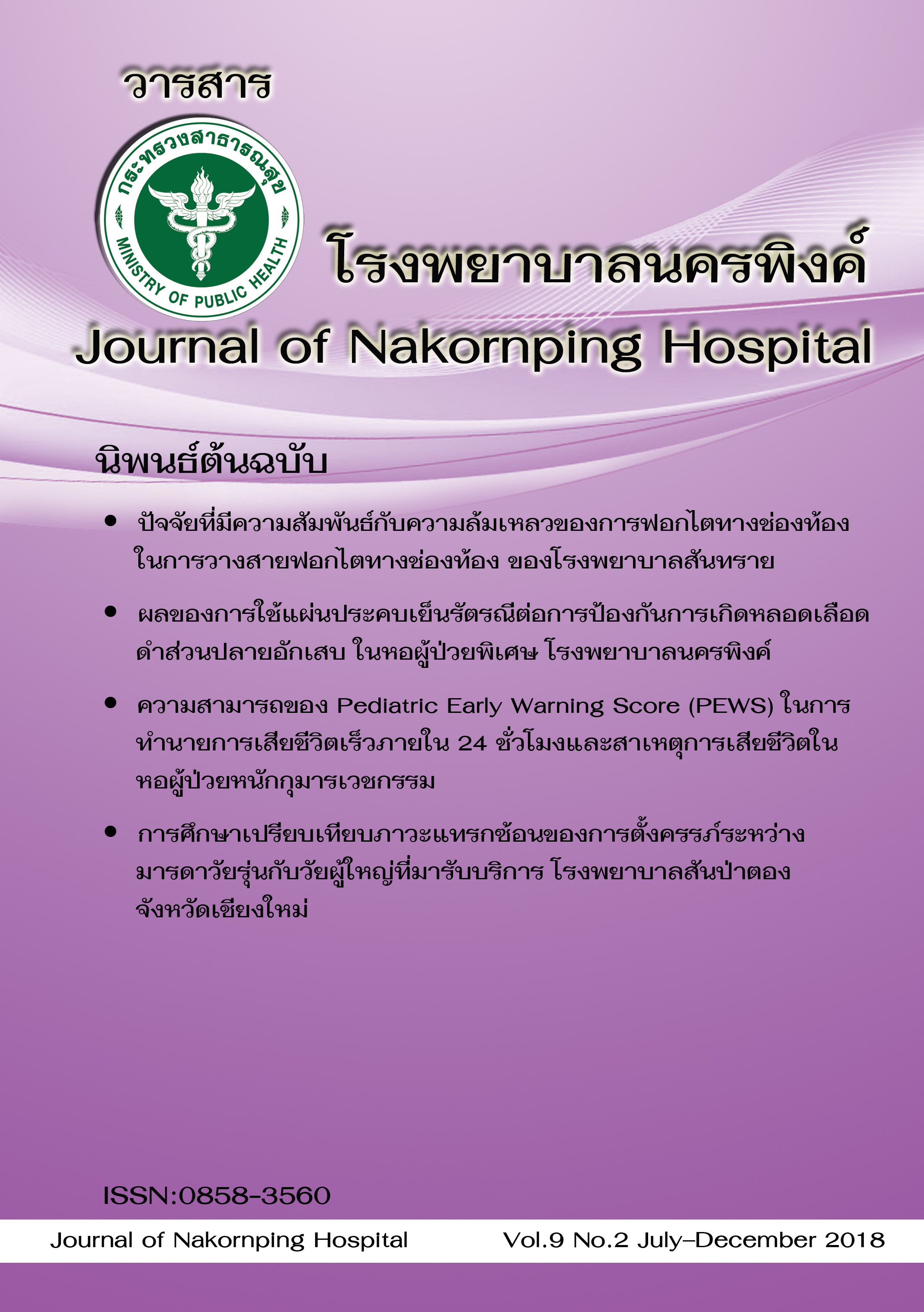Performances of the Pediatric Early Warning Score (PEWS) to predict early deaths within 24 hours and causes of death in pediatric intensive care unit
Abstract
Background: Different mortality rate in pediatric intensive care unit (PICU) has been reported in varied level of PICU services. No previous study has been done in Nakornping Hospital to explore mortality rate, mortality risk factors, PEWS score and early death risks.
Objectives: To study performances of PEWS score to detect early death in 24 hours, clinical risk factors in early death and describe a mortality rate and causes of death in PICU
Method: A retrospective cohort study was conducted during 1st January 2015 – 31st December 2017. Inclusion criteria were all PICU admissions and deaths aged less than 15 years old. Clinical data was gathered and PEWS score was generated from the first 24 hours of admission data. A mortality rate, causes of death, complications, ability of PEWS score prediction and factors associated with early death. Multivariable exponential risk regression was used for an analysis.
Results: Of 78 deaths during the study time, mortality rate was 6.57%. Patients died in 24 hours was 38.16%. The first five causes of death were pneumonia, sepsis, meningitis, drowning, and myocarditis. We analyzed PEWS in early death within and after 24 hours had mean PEWS 6.92 ± 1.91 and 5.17± 2.05 respectively, coefficient was 0.44 (95% CI 0.16-0.71) p = 0.002. PEWS ³ 5 and early death had RR 3.66 (95%CI 1.21-11.04) p=0.021. Factors related with early death were inotropic drugs used and high serum creatinine at the first 24 hours of admission.
Conclusion: PEWS score with a cut-off point at ³ 5 increased risk of death in 24 hours. Factors associated early death were inotropic drugs used and high serum creatinine.
Keywords: PICU, PEWS, early death in 24 hours, mortality, mortality risk factors
References
2. Khositseth A AN, Vaewpanich J. Death in a paediatric intensive care unit: A review over three years. Sri Lanka Journal of Child Health. 2012;41(4):166-70.
3. Inprom K. Treatment outcomes and factors associated mortality rate among pediatric patients admitted to pediatric intensive care unit at Chiang mai university hospital [dissertation]: Chiangmai:Chiangmai university; 2015.
4. Shashikala.V AB, C.Suresh Kumar. Analysis of Mortality in PICU of A Tertiary Care Teaching Hospital, Telangana- An Introspection. IOSR Journal of Dental and Medical Sciences. 2016;15(5):7-12.
5. Goncalves JP, Severo M, Rocha C, Jardim J, Mota T, Ribeiro A. Performance of PRISM III and PELOD-2 scores in a pediatric intensive care unit. Eur J Pediatr. 2015;174(10):1305-10.
6. Gulla KM, Sachdev A. Illness severity and organ dysfunction scoring in Pediatric Intensive Care Unit. Indian J Crit Care Med. 2016;20(1):27-35.
7. Pollack MM, Holubkov R, Funai T, Dean JM, Berger JT, Wessel DL, et al. The Pediatric Risk of Mortality Score: Update 2015. Pediatr Crit Care Med. 2016;17(1):2-9.
8. Costa GA, Delgado AF, Ferraro A, Okay TS. Application of the pediatric risk of mortality (PRISM) score and determination of mortality risk factors in a tertiary pediatric intensive care unit. Clinics. 2010;65(11):1087-92.
9. Akre M, Finkelstein M, Erickson M, Liu M, Vanderbilt L, Billman G. Sensitivity of the pediatric early warning score to identify patient deterioration. Pediatrics. 2010;125(4):e763-9
Downloads
Published
How to Cite
Issue
Section
License
The articles that had been published in the journal is copyright of Journal of Nakornping hospital, Chiang Mai.
Contents and comments in the articles in Journal of Nakornping hospital are at owner’s responsibilities that editor team may not totally agree with.



